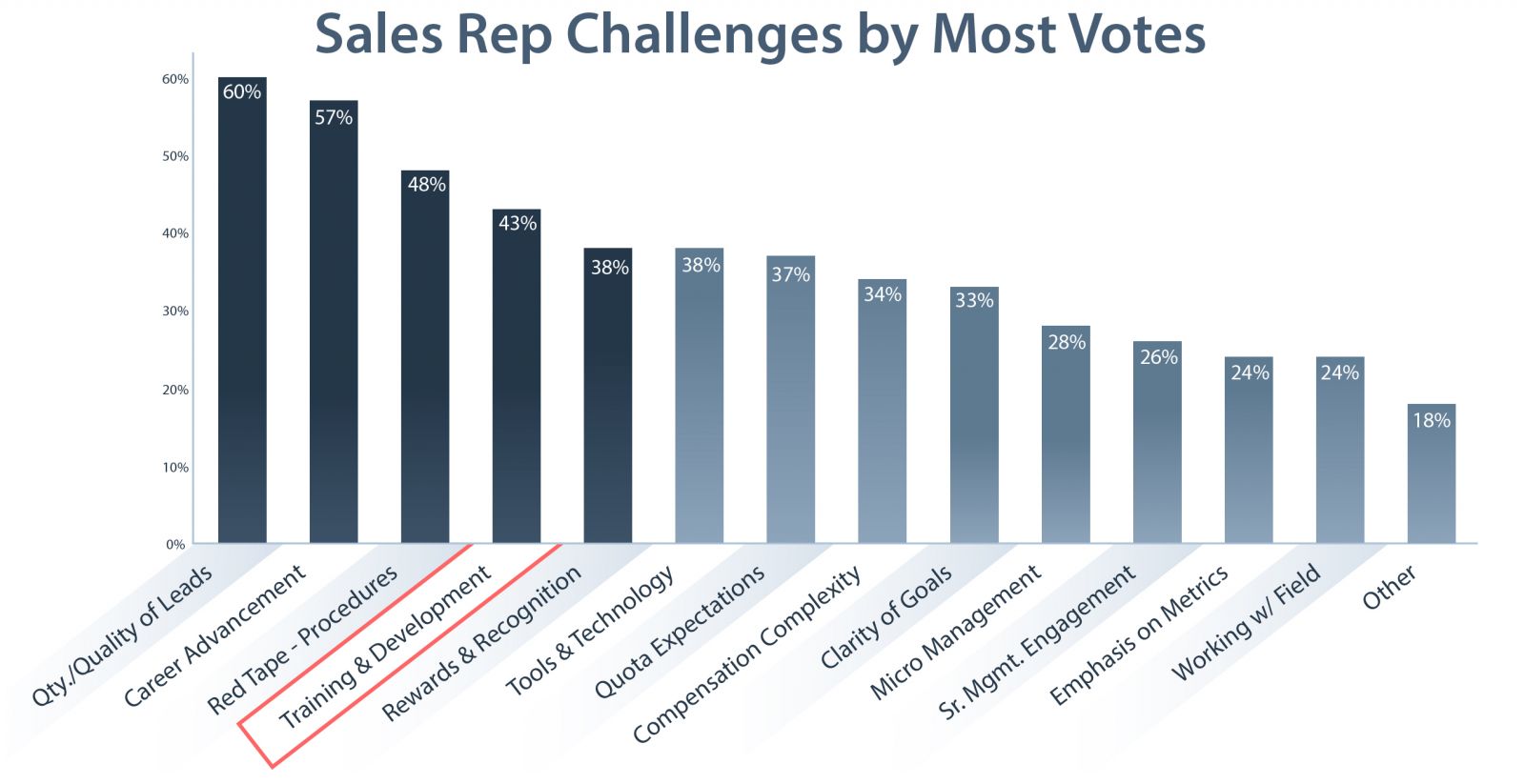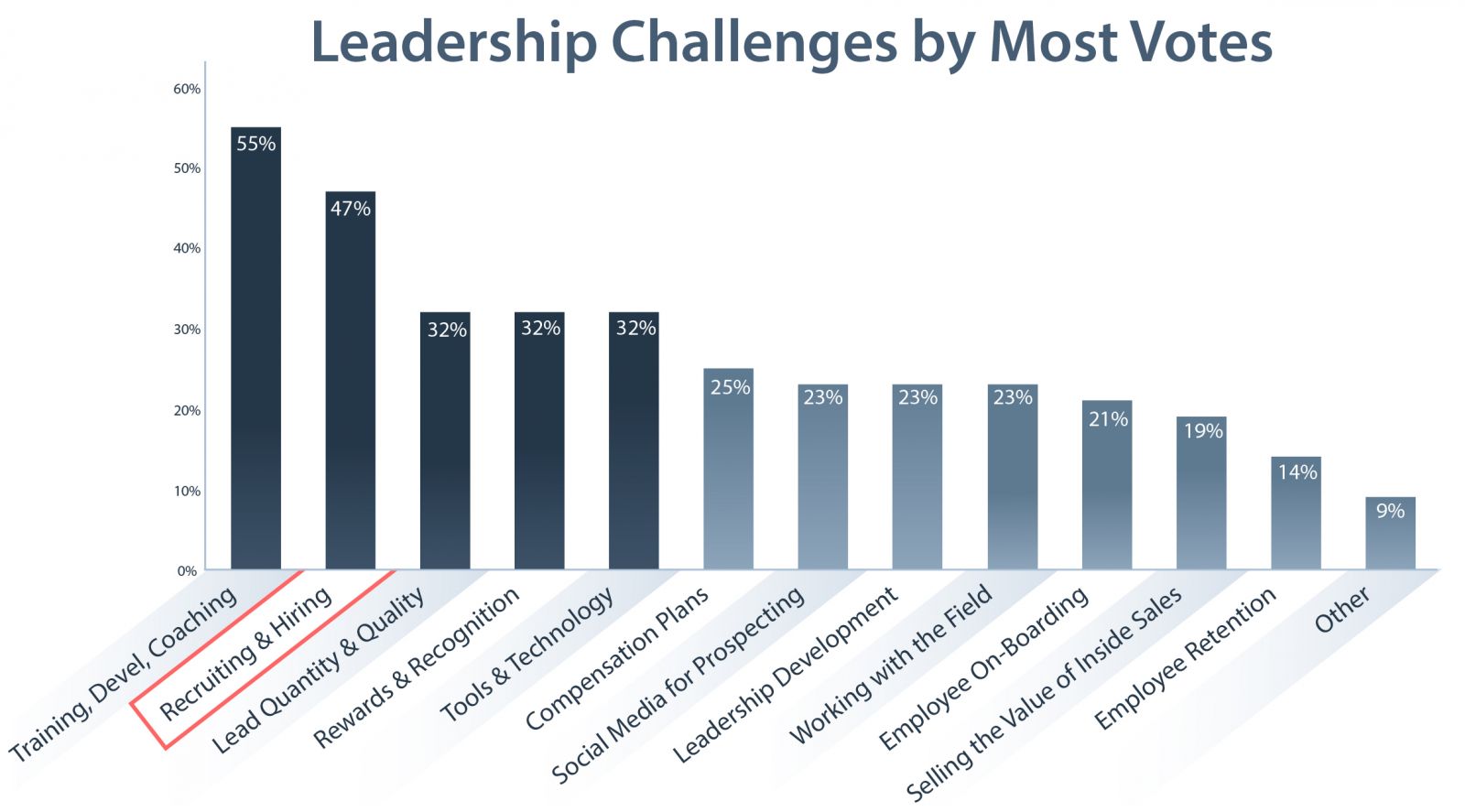A recent study of more than 800 front line sales reps and sales leaders highlights a disturbing trend in sales management. While organizations are making ever greater investment in technologies and operational processes to improve performance, sales reps are citing Training and Development as being one of their greatest challenges to improving performance.

Figure 1 Source: AA-ISP 2013 Leadership Survey
Not surprisingly, driven by the amount of effort and time required of sales managers to implement new technologies and processes, sales leaders identified Training, Development, and Coaching as their number one challenge to achieving greater success.

Figure 2 Source: AA-ISP 2013 Leadership Survey
Given the close correlation, you would think that it would be relatively straightforward to marshal the time and resources to address this gap, yet organizations struggle to develop solutions.
Root cause: Sales organizations are growing and drawing from a shallow pool of qualified candidates. Experienced reps who may be perceived as“most desirable” from a recruitment perspective, are crushing it with your competitors and are unlikely to leave. Therefore the bulk of your sales recruits are either inexperienced with limited training or prior sales education OR were under performers at their last job. During the interview process, both profiles showed enough “potential” that you were willing to take a chance. Managers, pressed for time and budget, therefore increasingly take risks of placing untested, under-trained reps into selling roles.
What can be done to reverse this trend: Launching deep, sustained training programs is only part of the solution. Adult learners do best by practice AND coaching. Imagine a team of top prospects hitting the field every day with a highly innovative playbook, but no coaches to guide the implementation or their development as a team. A lot of able-bodied talented wasted. Yet, this is what most sales managers are doing. They take their team through training camp then leave the field when the whistle blows for the opening day kick-off. Chaos ensues, careers are cut short. It just doesn’t work. Yet, we see this all the time.
Rather than repeat unnecessarily this unproductive cycle, we recommend sales managers take renewed interest and commitment to delivering coaching. Coaching is by far the most readily available resource sales leaders can deploy right now to immediately improve performance. Here are four keys to help you jumpstart your sales coaching discipline:
Key #1: Develop a coaching plan: All this talk of coaching and okay what are we talking about here. A systematic approach focuses on mastering one skill at a time that collectively builds a rep who will deliver long term sustained performance. Which skill you focus on developing first should be dictated by the impact the skill will have on the sales process your rep is trying to drive. For some organizations that may be increasing conversion rates on sales qualified leads; for others it may be coaching effectiveness to shorten the renewal cycle on service agreements. Whichever skill you focus on be sure your coaching plan should holistically address the “three spheres of knowledge” critical to any sellers’ success: Industry, Product and Selling Skills. Coaching across all three knowledge spheres provides an integrated view of selling and allow coaches to isolate individual “coaching drills” within a coherent, relevant structure.
Key #2: Focus on improving the middle performers: Managers often make the mistake on focusing their coaching and development efforts on the top 10% of performers, or worse the bottom 20%. Both approaches may make you feel good aligning yourself with top players or rooting out your underperformers. But where can you see the greatest improvement? The middle 70%. Just think: if you improve the performance of your middle 70% by just 10% you provide yourself with a multiplier effect that will certainly exceed a 10% improvement among your limited number of top 10% performers. [BTW the likelihood that you would see 10% improvement among your top reps is slim to none. They are already outperforming the rest of the team and the incentives you have on the table will dictate their ability to over-perform further. The bottom 20? This is a rescue mission– not a strategy to grow your business.]
Key #3: Coaching IS your job: If you are not proactively spending 30-40% of your time coaching your players you are doomed to fail (or at best underperform). If you are leading a team of sales managers, their time allocated to coaching should be in the 50- 70% range. If the bulk of your sales managers’ time is spent doing tasks that take them away from coaching, your organization alignment should be re-considered.
Key #4: Coach your Coaches: To achieve depth in your coaching efforts, focus on building your coaching bench. Managers and top performers should be enrolled in the coaching process and driving daily /weekly / monthly coaching sessions among their respective teams. Senior leaders can model exceptional coaching behavior, but often some of the best coaches rise from within the team lead or specialist ranks so be sure to keep a sharp eye out for those who exhibit such behaviors and enroll them as part of your coaching staff.
What Not To Do:
Inspection is a coaching opportunity, not the time to conduct a performance review: Many sales teams rely on regular pipeline inspection, yet do so from a performance perspective and, by doing so, undermine the opportunity to deliver effective coaching. One example: Sales leaders at a Fortune 50 technology company establisheda regular rhythm to conductmonthly pipeline inspections for all named accounts. Regrettably, given the approach of the sales leaders conducting the inspections, the account managers saw these activities as little more than a “spanking session” where managers hammer them about (real or perceived) performance issues rather than an opportunity to leverage management resources to get their pipeline healthy again.Instead of coming to the inspections in a collaborative frame of mind, account managers came ready to do battle defending all the actions and decisions they had taken during the course of any given pursuit. Recognizing this gap in expectations, sales leaders re-designed the inspections to create a neutral “coaching session” where focus was placed equally on sellers AND their managers to createsolutionsand remove obstacles that ultimately improved performance of both individual sellers as well as the account teams who participated.
Don’t coach once and forget it: So you lead an effect coaching session that appears to deliver some results. Excellent! Don’t stop: You may have optimized for one skill or one scenario, but there’s more work to be done. Manage coaching like all other disciplined activities: develop a schedule, prioritize areas for skills development and commit both sellers and managers to the effort.
Mark Ippolito is a Sr. Manager and Practice Leader for Lenati's Sales Strategy & Partner Channel Sales Solutions Practice. Lenati’s solutions for sales strategy and design, segmentation, account planning, field enablement, partner channel development and sales measurement have been deployed at leading technology, software, and telecommcompanies including Adobe, Google,Microsoft, T-Mobile, WebTrends and many more.






